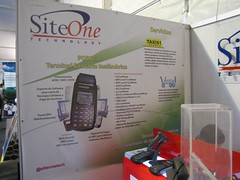The Global Positioning System (GPS) is a satellite-based navigation system made up of a network of about 18-24 satellites placed into orbit. GPS was originally intended for military applications, but in the late 1970s, the government made a system available for civilian use. GPS works in any weather conditions, anywhere in the world, 24/7. There are no cost for the use.
How it works
Antenna Booster Wireless

GPS satellites circle the earth twice a day in the same orbit and transmit signal information to down to mother earth. GPS take this information and use triangulation to calculate the user's exact location. The GPS receiver compares the time a signal was transmitted by a satellite with the time it was received. The time difference tells the GPS receiver how far away from the satellite it is. Now, with this distance measurements from a few more satellites, the receiver can determine the user's position and display it on the unit's electronic map.
A GPS receiver must be locked on to the signal of at least three satellites to calculate a 2d position (latitude and longitude) and track movement. With four or more satellites in view, the receiver can determine the user's 3D position (latitude, longitude and also altitude). Once the user's position has been determined, the GPS unit can calculate other information, such as speed, track, trip distance, distance to destination, sunrise and sunset time and a lot more.
How accurate is GPS?
Today's GPS receivers are extremely accurate, thanks to parallel multi-channel design. Garmin's 12 parallel channel receivers are quick to lock onto satellites when first turned on and they maintain strong locks, even in dense foliage or urban settings with tall houses. Certain atmospheric factors and other sources of error can affect the accuracy of GPS receivers. Garmin® GPS receivers are accurate to 15 meters on average.
Newer Garmin GPS receivers with WAAS (Wide Area Augmentation System) capability can improve the accuracy to less than three meters on average. No additional equipment or fees are required to take advantage of WAAS. Users can also get even better accuracy with Differential GPS (DGPS), which corrects GPS signals to within an average of three to five meters. The U.S. Coast Guard operates the most common DGPS correction service. This system consists of a network of towers that receive GPS signals and transmit a corrected signal by beacon transmitters. In order to get the corrected signal, users must have a differential beacon receiver and beacon antenna in addition to their GPS.
The GPS satellite system
The 18-24 satellites that make up the GPS space segment are orbiting the earth about 12,000 miles above us. They are constantly moving, making two complete orbits in less than 24 hours. These satellites are travelling at speeds of roughly 7,500 miles an hour.
GPS satellites are powered by solar energy only. They have backup batteries onboard to keep them running in the event of a solar eclipse, when there's no solar power. Small rocket boosters on each satellite keep them flying in the correct path.
Here are some other interesting facts about the GPS satellites (also called NAVSTAR, the official U.S. Department of Defense name for GPS):
o The first GPS satellite was launched in early 1978.
o A full constellation of 24 satellites was achieved in late 1994.
o Each satellite is built to last about 10-15 years. Replacements are constantly being built and launched into orbit.
o A GPS satellite weighs approximately 1,500 pounds and is about 16 feet across with the solar panels extended.
o Transmitter power is only 50 watts or less.
What's the signal?
GPS satellites transmit two low power radio signals, designated L1 and L2. Civilian GPS uses the L1 frequency of 1575.42 MHz in the UHF band. The signals travel by line of sight, meaning they will pass through clouds, glass and plastic but will not go through most solid objects such as buildings and mountains.
A GPS signal contains three different bits of information -- a pseudorandom code, ephemeris data and almanac data. The pseudorandom code is simply an I.D. code that identifies which satellite is transmitting information. You can view this number on your Garmin GPS unit's satellite page, as it identifies which satellites it's receiving.
Almanac data, which is constantly transmitted by each satellite, contains important information about the status of the satellite (healthy or unhealthy), current date and time. This part of the signal is essential for a good position view.
Sources of GPS signal errors
Factors that can degrade the GPS signal and thus affect accuracy include the following:
o Ionosphere and troposphere delays -- The satellite signal slows as it passes through the atmosphere. The GPS system uses a built-in model that calculates an average amount of delay to partially correct for this type of error.
o Signal multipath -- This occurs when the GPS signal is reflected off objects such as tall buildings or large rock surfaces before it reaches the receiver. This increases the travel time of the signal, thereby causing errors.
o Receiver clock errors -- A receiver's built-in clock is not as accurate as the atomic clocks onboard the GPS satellites. Therefore, it may have very slight timing errors.
o Orbital errors -- Also known as ephemeris errors, these are inaccuracies of the satellite's reported location.
o Number of satellites visible -- The more satellites a GPS receiver can "see," the better the accuracy. Buildings, terrain, electronic interference, or sometimes even dense foliage can block signal reception, causing position errors or possibly no position reading at all.
o Satellite geometry/shading -- This refers to the relative position of the satellites at any given time. Ideal satellite geometry exists when the satellites are located at wide angles relative to each other. Poor geometry results when the satellites are located in a line or in a tight grouping.
o Degradation of the satellite signal -- Selective Availability (SA) is an intentional degradation of the signal once imposed by the U.S. Department of Defense. SA was intended to prevent military adversaries from using the highly accurate GPS signals. The government turned off SA in May 2000, which significantly improved the accuracy of civilian GPS receivers.
What Is and How Does a GPS Work?
Bed Bugs Shopping New HTC Phones Sprint

















